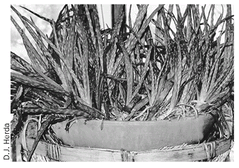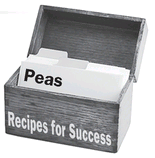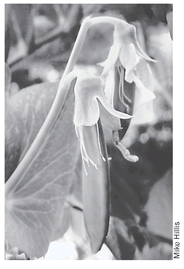3
Why Containers?
There are lots of reasons I prefer growing fruit and vegetables in containers over growing them in a conventional garden. For one, you can grow things in containers where you are physically unable to grow them in the ground. Lack of space, lack of light and lack of land can be difficult horticultural barriers to overcome, although I admit that I have in the past prevailed upon friends, neighbors and (especially) family members to lend me a miniscule plot of ground to furrow.
Another reason I enjoy container gardening is that I can control my plants’ environments more closely in a container than I can when they are tucked into Planet Earth. Rain or no rain, acidic or alkali soil, bugs, fungus, cutworms and even poachers (whether the four- or the two-legged kind) become far less of a problem when you grow your plants in containers, particularly when they are grown indoors.
Do you live in an arid climate, such as southern California, the high desert or anywhere within a thousand miles of Las Vegas? Not to worry. It rains on your container plants every time you fill up the watering can.
Do you need to grow acid-loving plants but have access only to alkaline garden soil? A few minor corrections to the growing medium, and you’ll have exactly the pH your container garden needs for healthy, productive growth.
Got bugs? Inquisitive dogs? Destructive neighbors? They are rarely a problem with container gardening, where you can place your pots indoors or out on a meticulously patrolled patio or porch in order to protect them from predators and other interlopers.
In fact, just about every advantage you can think of to growing fruit and vegetables in the ground you can achieve anywhere you like in a pot — and without most of the drawbacks to conventional gardening.
Case in point: Shortly after I married for the very first time (let’s not go there, okay?), my wife and I moved to a suburban Chicago home with a large fenced yard. Naturally, the first thing I did after closing on the property was to plant several fruit trees, a few blueberry bushes (how I love blueberries!) and roses. The next week, we drove 50 miles in the dead of night to a large home in another suburb where someone had run a newspaper advertisement for a black lab puppy for sale... free!
The week after that, we were back at the nursery, replacing the blueberry shrubs and trees that the dog had dug up and left to wither and die in the hot summer sun. Ditto, the week after that. If I hadn’t discovered the advantages of container gardening, we would either have run out of money or run out of dog.
In retrospect, the latter would not have been the worst idea I have ever conceived, although the beast did manage to outgrow her destructive tendencies in time, and my young son loved her dearly. Don’t ask me why.
My point is that container gardening saved my sanity, saved my relationship with my son and saved me from God knows how many more trips to the nursery. (I do not give up on my fantasies easily.)
Container gardening can also provide your plants with the light they need to grow successfully. There is little frustration on earth greater than sticking a beloved stalk of living, breathing (well, sort of ) tissue into the ground only to see it slowly wither and die from too little light. A lack of adequate light is one of the greatest reasons for gardening failure. I’ll write more about that later.
When planting in-ground, you’ll often find that the soil into which you stick your prized horticultural possession rarely receives the right amount of light for optimal growth. Even if the light is sufficiently strong to satisfy the plant’s need for life, it may not be strong enough to induce the plant to produce flowers or, more so, to set fruit and carry that fruit through to harvest.
The opposite can also be true. If you plant a shade-loving low-light plant such as lettuce or spinach into a plot of outdoor ground in full sunlight, you run the risk of burning it out and killing it.
Container plants, though, can be moved around to the best possible location to take advantage of the light for maximum growth and sustained health. I know some container gardeners (not me — I’m nowhere near ambitious enough for this) who set their light-loving plants in an eastern exposure to take advantage of the early morning sun and move them to the opposite end of the house as the light source shifts steadily toward the west.
Some people call that dedication. I call it fanatic. Whatever you call it, the point is that you have the option of placing container plants into a far greater array of lighting conditions than you would have by sticking your plants into holes in the middle of your backyard.
Fortunately, there are several simpler and more effective ways of giving your potted plants exactly the light they need for best possible growth than playing “follow the sun,” as some of my gardener friends do. We’ll talk more about those options later.
In the end, container gardening gives you lots of advantages over in-ground gardening with very few of the disadvantages.
To the Rescue
I live in the desert. Actually, I live in a house, and the house lives in the desert. Nevertheless, I buy plants that I enjoy having around me. Over the years, I have found that some of these plants have failed to return the favor. In particular, I can name several dozen specimens of Begonia, Swedish ivy (Plectranthus australis) and cucumber that I have tried and failed miserably to acclimate to my surroundings.
The only possible reason for their lack of reciprocation to all my best gardening efforts: an inhospitable environment. Namely, too much heat and not enough humidity.
By growing these and other species indoors in containers, I finally found success. Container gardening allows me to control the environment of these plants, including light, water, humidity and temperature, while enabling me to enjoy their beauty. As a bonus, the fruit and vegetables they provide me are mighty tasty!
Naturally, not everything in life is a sure thing, and the same holds true for container gardening. Over-watering — rarely a problem with plants in the Great Outdoors — can be a serious problem with container plants, particularly with plants kept in the house. Conversely, under-watering can take its toll on container plants, too, most often with potted plants kept outdoors.
Aloe vera is one of the easiest and healthiest plants to grow in containers, indoors or out! As a bonus, it’s great for aiding burns and digestive problems, which puts it right at home in the kitchen.
But, with a little common sense, some sound advice and a bit of practical experience, you’ll soon get the hang of growing plants in containers, and growing everything from bearing trees and shrubs to small fruit, vegetables and even edible cactus and succulents such as Aloe vera will become as easy as falling off a manure truck.
Oh, and that’s one more advantage to container gardening: you can add just the right amount and type of nutrients to your potting mixture to help keep your plants looking and growing their best, something that is often more difficult to do with in-ground plantings.
If none of this has yet convinced you that container gardening is your own personal wave of the future, that it is both economically sound and theoretically practical, that you can grow better, healthier, more attractive edible plants in containers than you can grow conventionally, here’s one last thought:
Plant a tree in the ground, and that’s where it stays. Plant one in a container, and it’s there for as long as you want it to be — no more, no less. You can change plants with the seasons, move your containers from one room to another, reposition plants within a room, stagger your plantings for a continuous harvest, set the plants outside in the summer and bring them inside during the cold days of winter, arrange them in groups and even combine multiple plants in a single container.
You can change color schemes to match your home’s furnishings, add texture and drama to your home’s design palette and create specific moods to meet your needs, all with a degree of flexibility unknown to conventional gardeners. And you can do all that while saving a ton of money on your grocery bill.
That’s one of the most attractive features of container gardening.
01:00 IN A MINUTE
• Container gardening is an efficient way of growing plants regardless of where you live.
• You can control your potted plant’s environment far more easily than you can with plants tucked into the ground.
• Growing plants in pots is not foolproof, but it comes as close as anything science has yet devised.
Peas (Pisum sativum)
Habit: Bush and trellis
Cultivars: Some suggested garden pea cultivars are:
• Little Marvel, Thomas Laxton, Wando, Freezonian, Frosty, Knight, Alderman (tall-growing), Sparkle and Green Arrow
Seed or Transplants: Both
Pot Size: Medium
Water: Water moderately to a soil depth of at least six inches, allowing soil to dry out between waterings.
Comments: When choosing what type of peas to grow, remember that vining or trellis varieties can quickly take over a space. In addition, they need something on which to crawl — a stake, trellis, open-weave curtain or even a nearby bookshelf — which may prove to be less than ideal. Bush varieties, on the other hand, are far more compact and therefore better suited for growing in pots.
Seeds: Plant seeds to a depth approximately twice the thickness of the seed; water and tamp soil firmly. Cover pot with a clear plastic container or wrap, and wait for germination. Keep soil moist but not saturated, and keep pot out of direct sunlight to avoid overheating. Uncover at the first sign of sprouts. Thin to approximately one plant per six inches for vining varieties or one plant per foot for bush varieties.
Peas (Pisum sativum)
Transplants: Place in hole no deeper than original root ball, and tamp around stem firmly.
Soil: Peas can be grown in a wide variety of soils, but good drainage is essential. Peas do best in a pH of 6.0 to 6.7.
Insects: Watch for aphids, leafhoppers and whiteflies, particularly if plants are kept outdoors. Solutions: Spray for insects with biologically friendly non-detergent soap mixed with water (1T per gallon water).
Diseases: Root rot, a fungus that lives in the soil, is a constant threat, especially to young plants. Also, powdery mildew and wilt can attack peas. Solutions: As a means of containing contamination, never plant peas in the previous year’s potting soil to reduce the incidence of soil-borne diseases that can build up over time.
Use only sterilized soil or potting mix and, if necessary, drench with one gallon of water mixed with six drops of tea tree oil, which has strong antibacterial and anti-fungal properties. Compost tea (see Chapter 15) contains organisms that attack fungus and should be used as both a supplement and treatment whenever possible.
Health Benefits: Green peas provide numerous nutrients, including vitamin C, which are instrumental in helping to prevent the development of cancer. A high intake of vitamin C has been shown to reduce the risks for virtually all forms of cancer, including leukemia, lymphoma and lung, colorectal and pancreatic cancers as well as sex-hormone-related cancers such as breast, prostate, cervix and ovarian cancers. Vitamin C is the body’s first and most effective line of antioxidant protection, helping to prevent damage to DNA while aiding the body in dealing with various environmental pollutants and toxic chemicals. It is also beneficial in enhancing the body’s immune system and inhibiting the formation of cancer-causing compounds such as nitrosamines, chemicals that the body produces after digesting processed meats containing nitrates.
Ready for the Kitchen: When pea pods are fully formed and beginning to swell, usually around 60-70 days after germination . Pick the pods off the plant, allowing the plant to continue producing peas throughout the growing season.
Annual Savings: Approximately $34 per year per person on average.



